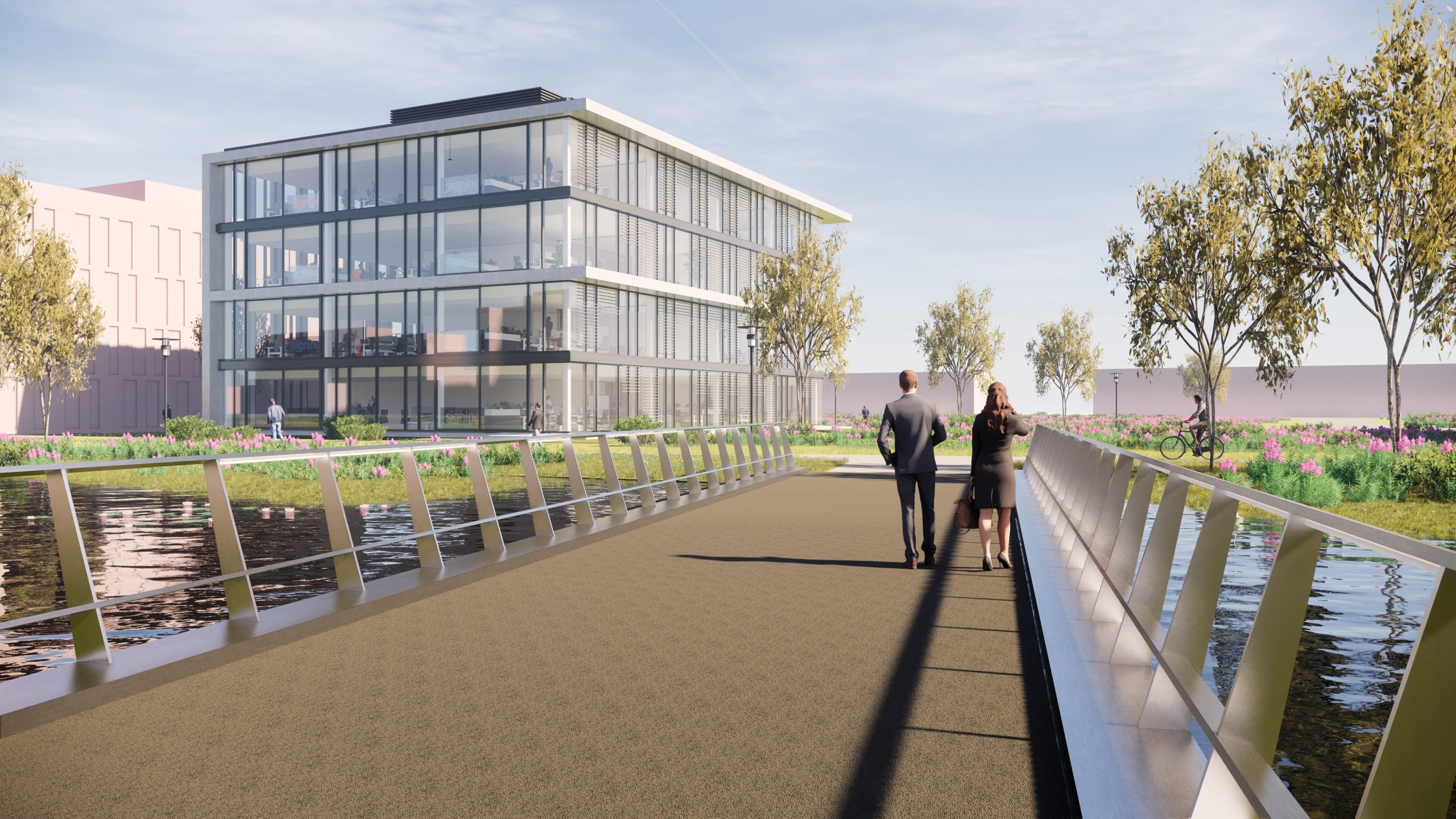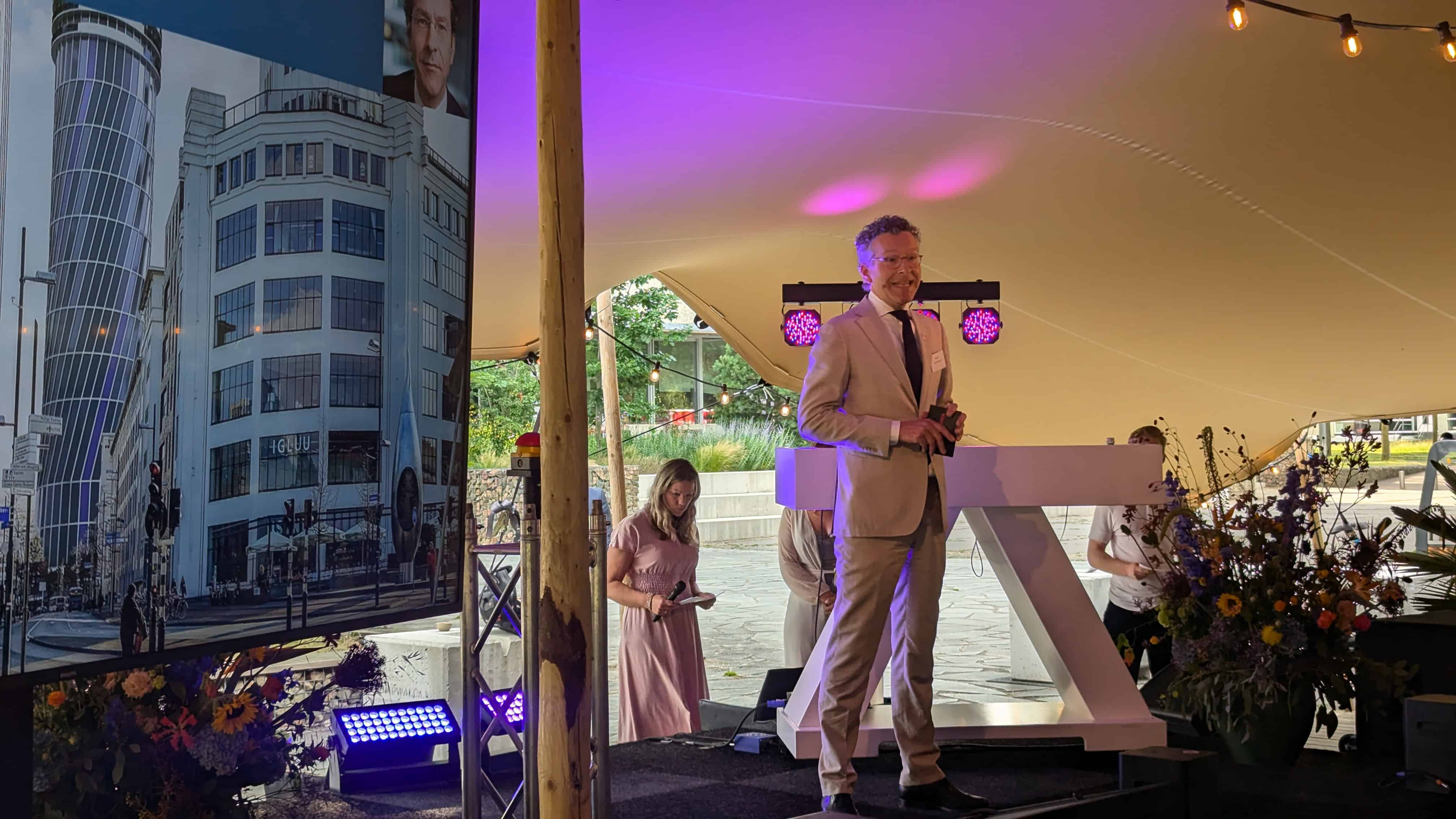
Attract talent and businesses with a smart and sustainable building. – That is the aspiration of High Tech Campus Eindhoven (HTCE) with their new office villa. The official opening of the building is planned for the spring of 2021. Commercial Director Jean-Paul van Oijen: “It fits in perfectly with our ambition to become Europe’s most sustainable Campus by 2025.”
The villa – which has glass facades from the ground up to high in the sky – will be situated on the waterfront in the middle of the campus. It aims to become a building that encourages you to take the stairs, and where employees can use their smartphones to control lighting and temperature. “This will be the office building of the future,” according to Oijen.
Meet, greet and work together
“On this site here we offer space to start-ups, scale-ups, small and medium-sized businesses, global companies and research institutions,” Van Oijen continues. “All of them are active in high tech and we want them to remain here and be able to grow”. The idea is that people working on campus can readily find each other and work together. Van Oijen wants to attract companies and institutes which complement that ecosystem.
“As there are 230 companies on the Campus, we have limited space available.” But those square meters are on the way. There will be space for new buildings on the south side of the campus. “We’ll see how this new, sustainable, and smart building will pan out. It’s a good case study to take a closer look at and see what will work for the following new building.”
A need for smarter and sustainable buildings
” I think it’s really wonderful that we, as a campus, are taking this step and constructing a genuinely innovative building,” Van Oijen adds, “I think that companies really should be doing this.” From an economic point of view, Van Oijen believes it may be cheaper in the short term to build a building that is not sustainable or smart. “You create a lower rental price that way. But I notice from the questions that we are being asked, that the market is demanding smarter and more sustainable buildings more and more. These buildings come with a lower energy bill as well as healthier, happier, and more vital employees. That’s also economically far more advantageous in the end.”
“A sustainable building is essential, especially for international companies. And it’s an advantage when it comes to attracting talent,” says Van Oijen. “The type of building that you are housed in as a company and the location all count for talented people. They want to work in a place and for a company that makes them proud. Sustainability and wellbeing are becoming more and more part of that sense of pride.”
An employee should feel at ease
The HTCE uses the WELL GOLD building standard as the benchmark for sustainability. This is a certification system for built-up environments and their effect on the health of those using the building. Along with sustainability, the wellbeing of users of a building is all-important too. “That an employee feels at ease there.” Can the windows be opened, does it lack a smoking area, is there enough daylight coming in, does the building encourage the user to be active? Those kinds of points. But also whether there is a connection with nature, Van Oijen explains.
“Of course, it’s also about the use of materials, for example, the optimum insulation quality for glass and facades. That lets light through, but keeps the heat out.” What distinguishes the building from the mainstream new office buildings in the region is that almost everything is controllable on a room-to-room basis. “We make sure that there is a smart infrastructure in place for connecting lighting, air conditioning, and temperature. With a minimum investment, a company can choose to simply install sensors and they work fine. These sensors make it possible to control each room practically on an individual level.”
Most sustainable campus in Europe
In line with the plans to become Europe’s most sustainable campus by 2025, the building is not connected to gas, but rather to a Heat Cold Storage (ATES) system. HTCE has constructed a network that stores heat underground that is left over from summer. This is reused again in winter. The ultimate aim is that all buildings on the campus will be connected to this, Van Oijen explains. “Those buildings that have been added in recent years already are, but in time all of them should be connected.”
This also applies to solar panels. This new building will be fitted with them, just like all the other buildings on campus. “We’ve planned that for this year and will continue working on that until the end of next year. This is how we will become more and more sustainable as a campus.” But according to Van Oijen, it’s not just about reducing CO2 emissions. It’s also about wellbeing. “That you have a pleasant place to walk in the afternoon. Or where you can play sports and meet people.” These are all facilities that the campus already has on offer.



